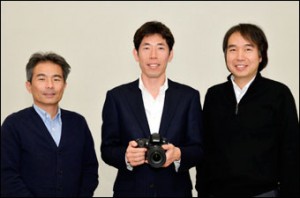 The Nikon D800 is the result of extensive development and design aimed to raise DSLR image quality to a new level. An interview with Nikon product designers Shinya Hara, Hiroshi Murakami, Eiji Yoshimatsu provides insight to the design process behind the D800. They share their perspectives on photography and how the D800 fits the specific needs of landscape and studio photographers.
The Nikon D800 is the result of extensive development and design aimed to raise DSLR image quality to a new level. An interview with Nikon product designers Shinya Hara, Hiroshi Murakami, Eiji Yoshimatsu provides insight to the design process behind the D800. They share their perspectives on photography and how the D800 fits the specific needs of landscape and studio photographers.
“Our goal was image quality a step above – far superior to any existing D-SLR camera – compressed into a compact camera body,” designer Shinya Hara reveals. The D800 was designed from the beginning to beat their best camera at the time, the 24-megapixel D3X. Hara describes their concept was to build “a camera with image quality, tone reproduction, and sharpness that were a match for high-resolution medium-format cameras.” The task was to put outstanding image quality beyond the D3X into a camera the size of the D700.
Image quality is more than pixel count. Murakami explains they acheived such high resolution by “increasing the precision of the image sensor, improving the performance of the optical low-pass filter to match that of a 36.3 megapixel sensor, and developing the high-speed processing technology.” Hara added these advances required “considerably more time on development than we have for other models.” Such improvements include increasing the memory buffer to deal with the enormous amount of data the 36-megapixel sensor provides, and using the technology of the D4 advanced autofocus and 91,000 pixel RGB metering sensor.
Eiji Yoshimatsu says the D800 will appeal to photographers wishing for medium format quality in a more managable size and weight. To that end, the D800 is both lighter and smaller than previous Nikon full-frame cameras. The 100% viewfinder and 3.2-inch LCD viewfinder provide unmatched visualation to take full advantage of the camera’s 36-megapixel resolution.
The features of the D800 were selected to appeal to a wide range of users, while providing the flexibility and ease-of-use to appeal to even the most methodical of photographers. For example, in a studio setting the difference in color temperature between background and strobe lighting can cause the color balance of the live view preview to appear incorrect. The D800 allows the photographer to choose separate white balance settings for live view and the final photograph.
Flexibility is important for the range of uses a typical photographer may encounter when using the D800. For example, less critical photographs can be made in 20-megapixel medium or 9-megapixel small sizes. The D800 offers four different image area settings: FX or DX to accomodate the full range of SLR lenses Nikon offers, as well as a 5:4 aspect ratio, and a 1.2X crop that is slightly more narrow than the standard FX frame. Each image area setting can be combined with an image size: large, medium or small.
In addition to the photographic features, the Nikon D800 brings an amazing array of video capabilities. To accomodate the dual-purpose use of the D800, a live view selector control was added. “This allowed us to clearly separate the settings for each type of live view and adapt them for improved ease-of-use,” Yoshimatsu explains. For example, in still picture mode the camera allows separate white balance settings, while in movie mode the user has direct control over microphone sensitivity and headphone monioring levels.
The D800 offers multi-area mode for recording of HD movies. This allows the user to use either FX or DX-format lenses to their full potential, while alow allowing for creative use of depth of field. One appeal of DSLR-based video is the large sensor size which allows one to use a large aperture to create extremely shallow focus area and pleasant blur of the background. However the shallow depth of field can create difficulting in focusing. Allowing a smaller-format sensor area to be used will increase the depth of field provided the equivalent focal length lens is used. According to Murakami, the multi-area selector allows the user to “take advantage of the FX and DX formats Nikon had already made available for still photography.”
The D800 is capable of producing outstanding images with detail and sharpness unmatched by any DSLR that came before it. And yet the the designers created a specialized D800E version without the traditional optical low pass filter. While the majority of photographers will choose the D800, the D800E was produced for a select group “who will only use the camera for landscapes or who need photographs with even higher resolution,” Hara explains. The low pass filter prevents color artifacts and moiré when shooting man-made objects with textures and fabrics. A higher degree of sharpness can be achieved with the D800E, provided the photographer employs proper technique and is able to avoid subjects that may produce moiré.

I ordered mine. I will first try the D800. I may also get the D800E